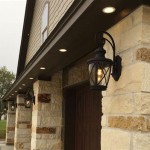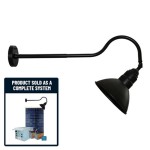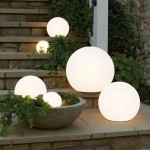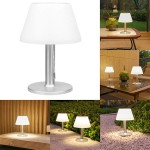Outdoor Chandelier Light For Gazebo
The selection and installation of outdoor chandelier lighting for a gazebo requires careful consideration of several factors. Gazebos serve as outdoor living spaces, providing shelter and ambiance for relaxation and entertainment. Lighting enhances this environment, extending the usability of the gazebo into the evening hours. Chandeliers, in particular, can offer a stylish and functional lighting solution, transforming the structure into a focal point of the landscape. However, choosing the appropriate outdoor chandelier requires understanding its suitability for outdoor conditions, power source options, installation methods, and aesthetic considerations.
The primary concern when installing a chandelier in a gazebo is its suitability for outdoor use. Unlike indoor chandeliers, outdoor chandeliers must withstand the elements, including moisture, sunlight, temperature fluctuations, and potential wind exposure. Failing to select an appropriate outdoor-rated fixture can lead to premature failure, electrical hazards, and compromised aesthetic appeal. Therefore, material selection, construction quality, and weatherproofing characteristics are paramount.
Outdoor chandeliers are typically constructed from materials resistant to corrosion and degradation. Common materials include powder-coated aluminum, stainless steel, wrought iron treated with protective coatings, and certain types of durable plastics. These materials offer varying levels of resistance to rust, fading, and structural damage caused by exposure to the elements. The finish is equally important; powder coating provides a durable, weather-resistant layer over the metal, preventing corrosion and maintaining the chandelier's appearance over time. The individual components, such as the wiring and bulb sockets, must also be rated for outdoor use to prevent water ingress and electrical shorts.
The Ingress Protection (IP) rating of an outdoor chandelier is a critical indicator of its ability to withstand water and dust. The IP rating consists of two digits; the first digit indicates protection against solid objects, and the second indicates protection against liquids. For outdoor applications, an IP rating of IP44 or higher is generally recommended. IP44 signifies protection against solid objects larger than 1 mm and splashing water from any direction. Higher IP ratings, such as IP65 or IP67, offer even greater protection against dust and water ingress, making them suitable for particularly exposed locations.
The power source for an outdoor gazebo chandelier presents another important consideration. Options include hardwiring to a dedicated electrical circuit, using a plug-in system with a Ground Fault Circuit Interrupter (GFCI) outlet, or utilizing solar-powered models. Each option has its advantages and disadvantages that must be weighed against the specific needs of the installation.
Hardwiring provides a permanent and reliable power source for the chandelier. This method requires the expertise of a qualified electrician to ensure safe and code-compliant installation. The electrician will run wiring from the main electrical panel to a junction box located within the gazebo. From the junction box, the chandelier is directly wired, providing a seamless and aesthetically pleasing solution. Hardwiring is generally preferred for its reliability and the absence of visible cords. However, it involves a more complex and costly installation process compared to other options.
Plug-in chandeliers offer a more flexible and easily reversible option. These chandeliers come with a power cord that plugs into a standard electrical outlet. To ensure safety, the outlet should be a GFCI outlet, which is designed to trip and cut off power in the event of a ground fault, preventing electrical shock. Plug-in chandeliers are suitable for gazebos with existing electrical outlets or where running new wiring is impractical. While easier to install than hardwired models, the presence of a visible cord can detract from the overall aesthetic. The cord must also be protected from the elements to prevent damage and potential hazards.
Solar-powered chandeliers offer an environmentally friendly and energy-efficient alternative. These chandeliers utilize photovoltaic cells to convert sunlight into electricity, which is stored in rechargeable batteries. Solar-powered chandeliers do not require any wiring, making them easy to install and relocate. However, their performance depends on the amount of sunlight available, and they may not provide sufficient illumination in shaded areas or during prolonged periods of cloudy weather. The brightness and battery life of solar-powered chandeliers can also be limited compared to hardwired or plug-in models. Proper placement of the solar panel is crucial for optimal performance, ensuring it receives direct sunlight for several hours each day.
Determining Size and Style
Choosing the appropriate size and style of the outdoor chandelier is essential for achieving the desired aesthetic effect and ensuring adequate illumination. The size of the chandelier should be proportional to the dimensions of the gazebo. A chandelier that is too large can overwhelm the space, while one that is too small may appear insignificant and fail to provide sufficient light. As a general guideline, the diameter of the chandelier should be approximately one-third to one-half the width of the gazebo.
The height of the chandelier is also an important consideration, especially if the gazebo is used for dining or other activities where headroom is important. The bottom of the chandelier should be at least seven feet above the floor to avoid obstructing views or causing head injuries. In gazebos with lower ceilings, a shorter chandelier or a flush-mount fixture may be more appropriate. The chain or downrod length of the chandelier can be adjusted to achieve the desired height. Proper hanging height ensures both functionality and safety.
The style of the chandelier should complement the architectural style of the gazebo and the overall landscaping. Outdoor chandeliers are available in a wide range of styles, from traditional and ornate to modern and minimalist. Traditional chandeliers often feature intricate metalwork, crystal accents, and candle-style bulbs. Modern chandeliers typically have simpler designs, clean lines, and geometric shapes. The choice of style depends on personal preference and the desired ambiance. For example, a rustic gazebo may benefit from a chandelier with a weathered finish and natural materials, while a contemporary gazebo may be better suited to a sleek, modern design.
Installation Considerations
The installation of an outdoor chandelier should be performed carefully and in accordance with local electrical codes. Whether hardwiring, plugging in, or installing a solar-powered model, safety is paramount. Before beginning any electrical work, it is essential to disconnect the power supply to the circuit. If uncertain about any aspect of the installation, it is best to consult a qualified electrician.
For hardwired installations, the electrician will typically install a junction box in the center of the gazebo ceiling, ensuring it is properly supported and grounded. The chandelier wiring is then connected to the junction box wiring, following all applicable electrical codes. The electrician will also ensure that the wiring is protected from the elements and that all connections are secure. A weatherproof canopy is typically used to cover the junction box and protect the wiring from moisture.
Plug-in chandeliers require less extensive installation, but safety precautions should still be observed. The GFCI outlet should be tested regularly to ensure it is functioning correctly. The power cord should be kept out of walkways to prevent tripping hazards, and it should be protected from damage caused by lawnmowers or other equipment. If the cord needs to be extended, use an outdoor-rated extension cord. Regularly inspect the cord for any signs of wear or damage, and replace it if necessary.
Solar-powered chandeliers are generally the easiest to install, as they do not require any wiring. The solar panel should be placed in a location where it can receive direct sunlight for several hours each day. The chandelier is then hung from the gazebo ceiling, typically using a chain or hook. Ensure the hanging mechanism is strong enough to support the weight of the chandelier. Regular cleaning of the solar panel is necessary to maintain its efficiency. Over time, dust and debris can accumulate on the panel, reducing its ability to absorb sunlight.
Maintenance and Longevity
Proper maintenance is crucial for extending the lifespan of an outdoor gazebo chandelier and ensuring its continued performance. Regular cleaning, inspection, and replacement of worn parts can help prevent costly repairs and maintain the chandelier's aesthetic appeal. The frequency of maintenance depends on the environment and the type of chandelier. Gazebos located in coastal areas or areas with high humidity may require more frequent maintenance due to the increased risk of corrosion.
Cleaning the chandelier is essential for removing dirt, dust, and debris that can accumulate over time. Turn off the power to the chandelier before cleaning. Use a soft cloth or brush to gently remove loose dirt and dust. For more stubborn dirt, use a mild soap and water solution. Avoid using abrasive cleaners or scouring pads, as they can damage the finish. Rinse the chandelier with clean water and dry it thoroughly with a soft cloth. For chandeliers with crystal accents, use a specialized crystal cleaner to maintain their sparkle.
Regular inspection of the chandelier should include checking for signs of corrosion, loose connections, and damaged wiring. Repair any damage promptly to prevent further deterioration. If rust is present, remove it with a wire brush and apply a rust-inhibiting primer and paint. Tighten any loose screws or connections. Replace any damaged wiring or components with outdoor-rated replacements. Ensure the chandelier is properly grounded to prevent electrical hazards. Periodic inspection helps identify and address potential problems before they escalate into more serious issues.
Replacing the light bulbs is another essential aspect of chandelier maintenance. Use bulbs that are specifically designed for outdoor use, and choose bulbs with the appropriate wattage for the fixture. LED bulbs are a good option for outdoor chandeliers, as they are energy-efficient, long-lasting, and available in a variety of colors and brightness levels. When replacing bulbs, turn off the power to the chandelier and allow the old bulb to cool before handling it. Dispose of the old bulb properly. Consider using a dimmer switch to adjust the brightness of the chandelier and create different moods.

25 Gorgeous Outdoor Chandeliers

Pergola Lighting Ideas

Outdoor Solar Chandelier For Your Pergola Easy Diy Installation

Pergola Lighting Ideas

Wilson Fisher 3 Light Battery Operated Outdoor Chandelier Big Lots Chandeliers

Canvas Sonoma Outdoor Warm White Led Solar 6 Light Chandelier For Patio Gazebo Canadian Tire

Jazava 1 Light Black Outdoor Pendant Chandelier Hanging For Porch Gazebo Entry With Height Adjustable Chain Hd5hx62h Bg The Home Depot

Holiday Living Gazebo Chandelier Led 12 In Metal Black C60541 Réno Dépôt

25 Gorgeous Outdoor Chandeliers

Jazava 1 Light Black Outdoor Pendant Chandelier Hanging For Porch Gazebo Entry With Height Adjustable Chain Hd5hx62h Bg The Home Depot







